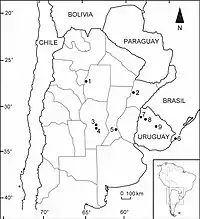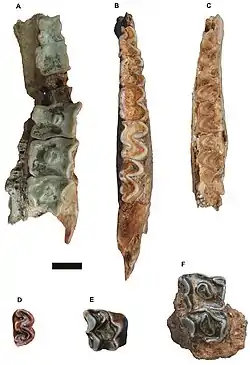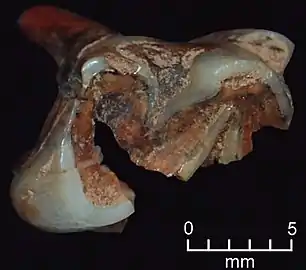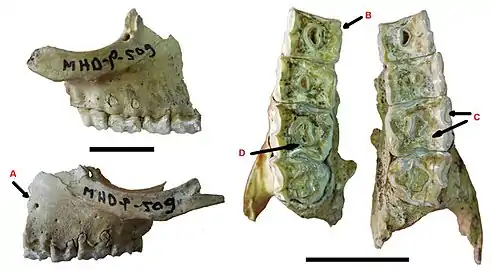Neolicaphrium
Neolicaphrium is an extinct genus of ungulate mammal belonging to the extinct order Litopterna. This animal lived from the Late Pliocene (Chapadmalalan) to the Late Pleistocene (Lujanian) in southern South America, being the last survivor of the family Proterotheriidae.
| Neolicaphrium | |
|---|---|
 | |
| Right hemimandible of N. recens | |
| Scientific classification | |
| Kingdom: | |
| Phylum: | |
| Class: | |
| Order: | |
| Family: | |
| Subfamily: | Proterotheriinae |
| Genus: | Neolicaphrium Frenguelli 1921 |
| Type species | |
| Neolicaphrium recens Frenguelli 1921 | |
| Species | |
Species

The genus includes two species, the type species N. recens and N. major. The fossil found of N. major, one jaw, come from the Miramar Formation in Chapadmalal, Argentina and correspond to the Chapadmalalan mammal age of South America (4.0 to 3.0 million years ago, in the Pliocene). N. recens appeared in the Ensenadan age (1.2-0.8 million years ago) and the species survived until the Lujanian age (800,000 and 11,000 years ago). Fossils of this species have been found in the Argentine provinces of the northeast, in Córdoba, Corrientes, Tezzanos Pinto Formation, Santa Fe and Santiago del Estero,[3] in the southern Brazilian state of Rio Grande do Sul and the Sopas Formation of the Salto Department in Uruguay.[4] N. recens is known from a partial skull, partial jaws, teeth and bones of the ankle and the forefeet.[5] A fragmentary humerus, previously assigned to the doubtful species "Proterotherium berroi", could also be referred to this species.[6]
Description

Neolicaphrium was a proterotherid of small (N. recens) to medium (N. major) size. N. recens, weighing about 37 kilograms was one third smaller than N. major. In general terms, Neolicaphrium resembled Thoatherium of the Miocene, one of the most famous proterotherids, by its relatively graceful built adapted to a cursorial locomotion, although without presenting the extreme monodactyly that characterizes Thoatherium, so that still retained its three fingers in each hand and foot. Similar to the smaller deer of today, such as the pudus, the pampas deer and the muntiacus, Neolicaphrium was a browsing herbivore. The isotopic analysis of the fossils indicates that Neolicaphrium fed mainly on fruits and to a lesser extent on terrestrial plants that grew at ground level, and that leaves were only a very limited part of their diet.[7]
The composition of the fauna of the Sopas Formation in Uruguay, where fossils of N. recens from the late Pleistocene have been found,[8] indicates that Neolicaphrium was a resident of savannahs and open tree forests. The rocks of the Sopas Formation were deposited in a gallery forest with rivers and Neolicaphrium lived there along with other mammals such as tapirs, the white-lipped peccary, the prehensile tail porcupine Coendou magnus, the capybara, the jaguar and the otter, species that characterize the tropical forest areas of South America.[9]
Extinction
Previously it was thought that the family Proterotheriidae became extinct during the Pliocene, as a consequence of the climatic changes that occurred in the transition to the Pleistocene, along with the notoungulate pachyruchines and the argyrolagid marsupials. The fossil record of N. recens however, showed that this group survived until the late Pleistocene in forest areas, outside the typical Pampa regions of the Southern Cone that were predominant during the Quaternary ice ages; However, this idea was rejected until the 21st century, when the new fossil finds allowed to corroborate its presence in the Pleistocene. In the Sopas Formation have been found also fossils of several types of deer (Pampas deer and an extinct form).[10] Neolicaphrium therefore coexisted throughout the Pleistocene with ungulate mammals of holarctic origin. Both competition with these animals, which reached South America during the Great American Biotic Interchange, and the environmental changes occurring since the end of the Miocene, which led to the disappearance of forest areas, may have contributed the decline and extinction of proterotherids.[11]
Gallery
 M2 molar of N. recens
M2 molar of N. recens Right hemimandible of N. recens
Right hemimandible of N. recens Mandible of N. recens, Sopas Formation
Mandible of N. recens, Sopas Formation
References
- Soria, M.F. 2001. Los Proterotheriidae (Litopterna, Mammalia), sistemática, origen y filogenia. Monografías del Museo Argentino de Ciencias Naturales, 1:1-167
- Frenguelli, J. 1921. Sobre un proterotérido del Pampeano superior de Córdoba, Neolicaphrium recens, nov. Actas de la Academia Nacional de Ciencias en Córdoba, 7:7-23
- Gaudioso et al., 2017, p.24
- Scherer, C. S., Pitana, V. G., & Ribeiro, A. M. (2009). Proterotheriidae and Macraucheniidae (Litopterna, Mammalia) from the Pleistocene of Rio Grande do Sul State, Brazil. Revista Brasileira de Paleontologia, 12(3), 231-246.
- Ubilla, M., Perea, D., Bond, M., & Rinderknecht, A. (2011). The first cranial remains of the Pleistocene Proterotheriid Neolicaphrium Frenguelli, 1921 (Mammalia, Litopterna): a comparative approach. Journal of Vertebrate Paleontology, 31(1), 193-201.
- Corona, A., Perea, D., & Ubilla, M. (2015). The humerus of Proterotheriidae (Mammalia, Litopterna) and its systematic usefulness: the case of “Proterotherium berroi” Kraglievich, 1930---Preprint. Ameghiniana.
- Morosi, E., & Ubilla, M. (2017). Dietary and palaeoenvironmental inferences in Neolicaphrium recens Frenguelli, 1921 (Litopterna, Proterotheriidae) using carbon and oxygen stable isotopes (Late Pleistocene; Uruguay). Historical Biology, 1-7.
- Corona et al., 2019, p.158
- Bond, M., Perea, D., Ubilla, M., & Tauber, A. (2001). Neolicaphrium recens Frenguelli, 1921, the only surviving Proterotheriidae (Litopterna, Mammalia) into the South American Pleistocene. Palaeovertebrata, 30(1-2), 37-50.
- Ubilla, M., Perea, D., Rinderknecht, A., & Corona, A. (2009). Pleistocene mammals from Uruguay: biostratigraphic, biogeographic and environmental connotations. Quaternário do Rio Grande do Sul (Ribeiro, AM, Bauermann, SG & Scherer, Eds.) Sociedade Brasileira de Paleontología, Porto Alegre, 217-230.
- Bond, M., Ortiz-Jaureguizar, E., & Villafañe, A. L. (2006). Cambios en la riqueza taxonómica y en las tasas de primera y última aparición de los Proterotheriidae (Mammalia, Litopterna) durante el Cenozoico. Estudios Geológicos, 62(1), 155-166.
Bibliography
| Wikimedia Commons has media related to Neolicaphrium. |
- Corona, Andrea; Martín Ubilla, and Daniel Perea. 2019. New records and diet reconstruction using dental microwear analysis for Neolicaphrium recens Frenguelli, 1921 (Litopterna, Proterotheriidae). Andean Geology 46. 153–167. Accessed 2019-02-28.
- Gaudioso, P.J.; G.M. Gasparini; R. Herbst, and R.M. Bárquez. 2017. First record of the Neolicaphrium recens Frenguelli, 1921 (Mammalia, Litopterna) in the Pleistocene of Santiago del Estero Province, Argentina. Papéis Avulsos de Zoologia 57. 23–29. Accessed 2019-02-28.